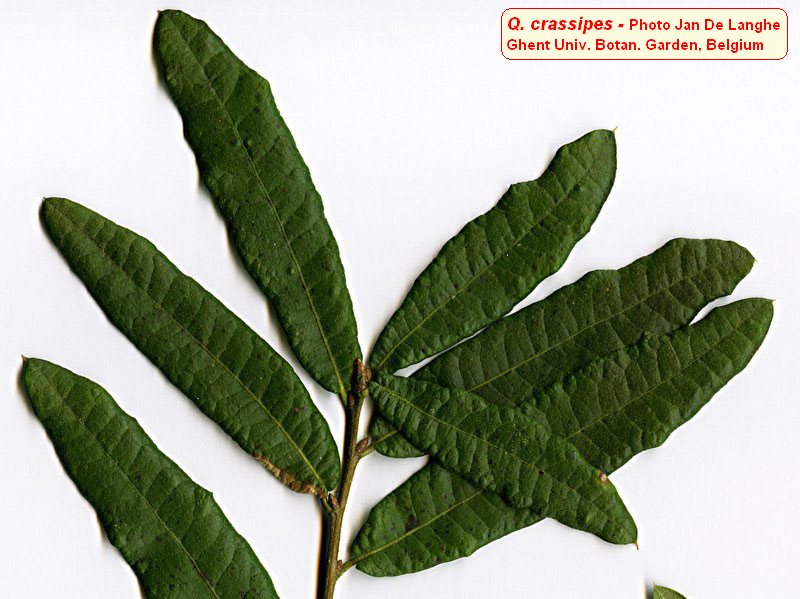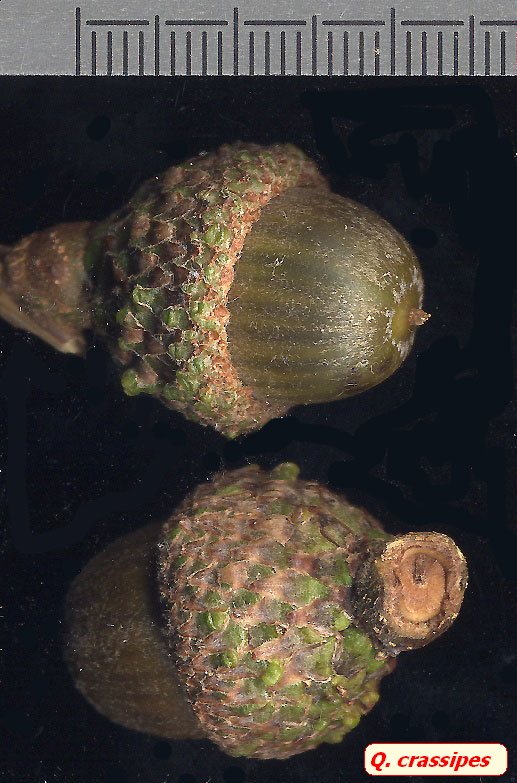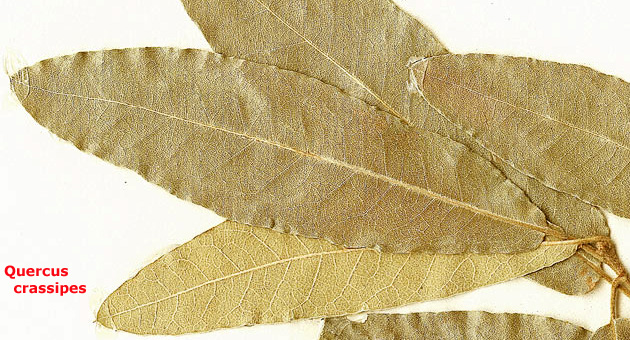| Quercus crassipes | |
| Author |
Bonpl. 1809 Pl. Aequinoct. 2: 37 Diagnosis here |
| Synonyms | castanea var. glabrata (Liebm.
ex Seem.)Trel. colimae Trel.1924 Diagnosis here crassipes var. angustifolia Humb. & Bonpl.1809 cuajimalpana Trel. 1924 imbricariaefolia Trel. Diagnosis here malifolia Trel. Diagnosis here mexicana Benth. 1840, not Bonpl. 1809 mexicana f. angustifolia (Bonpl.) Trel. 1924 mexicana f. glabrata Trel. 1924 mexicana var. glabrata Liebm. ex Seem. mexicana sensu Trel. 1924 obovalifolia E. Fourn. ex Trel.1924 (A. Camus : n° 316) |
| Local names | encino capulincillo; |
| Range | Mexico (Guanajuato, Hidalgo, Jalisco, Mexico, Michoacan, Morelos, Oaxaca, Puebla, Querretaro, Tlaxcala); 2000 to 3500 m; introduced in Great Britain in 1839 by Hartweg; |
| Growth habit | tree or shrub, 4 to 20 m; trunk 0.4-1 m in diameter, sometimes more; |
| Leaves |
2.5-9 cm x 1-3; deciduous or semi-evergreen; leathery; narrowly elliptic, or lanceolate or oblanceolate; base rounded or subcordate; apex acute, aristate; margin very thick, slightly rolled under, entire or sometimes slightly wavy; young leaves with dense, yellowish tomentum both sides (adaxially mainly on midrib); mature leaves dark greyish green adaxially, hairless (except along midrib or only near its base); abaxially with yellowish grey fasciculate stipitate trichomes (5-6 rayed, stalked, spreading trichomes), persistent but less dense in autumn; 10-20 vein pairs, prominent beneath like the midrib, forked before reaching margin, at an angle of nearly 90° with the midrib; adaxially the midrib is impressed; bullate epidermis; petiole thick, yellowish, tomentose or glabrescent, 2-10 mm long. |
| Flowers | in May; staminate carkins 3-6 cm long, bearing 15-20 flowers with 5 stamens 3 mm long, and apiculate anthers; pistillate flowers 1-2 on a short peduncle 0.5 cm long; |
| Fruits | acorn 1-2 cm long, ovoid, hairless except at the mucronate apex; singly or paired on a 2-8 mm long peduncle, thicker than the twig that bears it; cup half-round or conical, enclosing 1/3 of nut, with rim usually rolled inside or at least thickened, with thin, slightly tomentose scales triangular at apex; maturing in 2 years, from September to November; |
|
Bark, twigs and |
bark dark grey, fissured and scaly; twig slender (1-2 mm wide), pliable, at first densely yellowish tomentose, then with minute pubescence, round or angled in cross-section, with some pale lenticels; bud ovoid, rounded, hairless, with ciliate scales, 2-4 mm long, with deciduous stipules 7-8 mm long; |
| Hardiness zone, habitat | hardy in zone 7; prefers deep, dry soils (not too much); |
| Miscellaneous |
-- A.Camus : n° 315; |
| Subspecies and varieties |
|
| Pictures |
|



